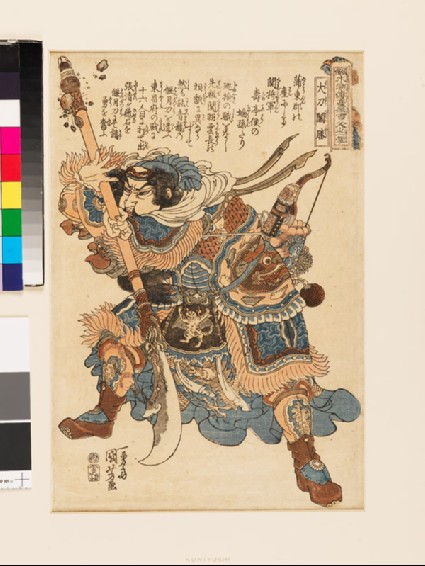Browse: 766 objects
- Reference URL
Actions
Daitō Kanshō (Guang Sheng)
-
Details
- Series
- One of the 108 Heroes of the Popular Water Margin
- Associated place
- Date
- 1827 - 1830
- Artist/maker
-
Utagawa Kuniyoshi (1797 - 1861) (designer)
- Associated people
-
Kagaya Kichibei (active c. 1804 - 1880) (publisher)
- Material and technique
- woodblock
- Dimensions
-
mount 55.4 x 40.5 cm (height x width)
print 38.5 x 26.2 cm (height x width)
- Material index
- Technique index
- Object type index
- No. of items
- 1
- Credit line
- Presented by George Grigs, Miss Elizabeth Grigs, and Miss Susan Messer, in memory of Derick Grigs, 1971.
- Accession no.
- EA1971.98
-
Further reading
Impey, Oliver, and Mitsuko Watanabe, Kuniyoshi's Heroes of China and Japan: A Selection of Warriors from Two Series of Prints and a Painting by Utagawa Kuniyoshi (1798 - 1861), the Suikoden of 1827 and the Taiheki of 1848-9 (Oxford: Ashmolean Museum, 2003), no. 10 on p. 10, illus. p. 22 pl. 10
Location
-
- currently in research collection
Objects are sometimes moved to a different location. Our object location data is usually updated on a monthly basis. Contact the Jameel Study Centre if you are planning to visit the museum to see a particular object on display, or would like to arrange an appointment to see an object in our reserve collections.
Publications online
-

Kuniyoshi’s Heroes of China and Japan
Suikoden chapter 62
Daitō Kanshō was born in Hotō-gun, the grandson of Juteikō (Shouting hou), and was a descendant of the great general, Kan-u Unchō (Guanyu Yunchang), during the time of the Three Kingdoms; he is thought to have greatly resembled him. He was a municipal guard and always used a glaive called a 'seiryūtō', or ‘green dragon’ the origin of his nickname, Daitō (big spear). While he was young, he became well versed in martial arts and weaponry and his style of fighting was similar to that of Kan-u.
This print shows the battle of Tōshōfu (Dongchang fu) where Kanshō is blocking the stones that are being thrown by Botsu-usen Chōsei (Zhang Qing), using the butt of his enormous glaive to parry them. He was considered particularly brave to fight against Chōsei who was famous for being able to hit his target with a stone ten times out of ten. This print of Kanshō forms a diptych with a print of Chōsei in Kuniyoshi's Suikoden, lacking in the collection.
© 2013 University of Oxford - Ashmolean Museum

